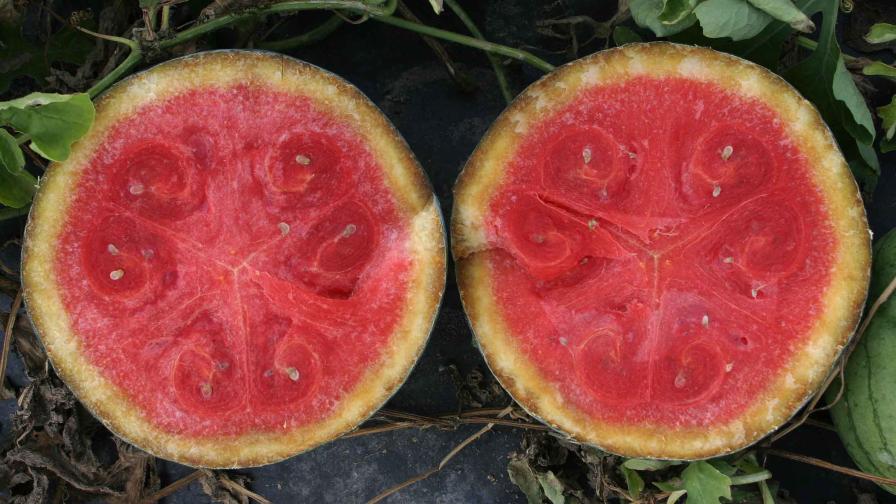Take a Closer Look at Watermelon Vine Decline

A team of researchers from the University of Florida, Florida Department of Citrus, and the USDA-ARS discovered that watermelon vine decline was caused by a whitefly-transmitted virus, which they called squash vein yellowing virus.
Photo by Dr. Scott Adkins
Symptoms of watermelon vine decline include a slight internal yellowing of stem tissue in the crown area, wilting vines, scorched and brown leaves, defoliation, and rapid mature vine collapse. Frequently, fruit are observed with greasy necrosis (brown) on the interior portion of the rind that render the fruit unmarketable. Fruit quality is greatly reduced.
Watermelon vine decline strikes as the crop approaches harvest or soon after first harvest. Disease progress is rapid. Symptoms may develop and affect more than 80% within a week to 10 days.
Since first observed in 2003, the disease has caused severe monetary losses to watermelon growers in South Florida. Over the past few years, the occurrence of vine decline in Southwest Florida has waned as a couple of other whitefly-transmitted viruses, most notably cucurbit crumple leaf virus and cucurbit yellow stunting disorder, have become more common. This year, vine decline again reared its ugly head in Southwest Florida, causing several watermelon fields to be abandoned due to internal fruit quality.
Survival and Spread
The squash vein yellowing virus is transmitted by the silverleaf whitefly. The host range appears to be limited to cultivated cucurbits including squash and watermelon as well as two weedy species of cucurbits, Balsam-apple (Momordica charantia L.) and creeping cucumber (Melothria pendula L.). These weeds may be important reservoirs for the virus and help it to survive between crops.
Management Methods
Management is similar to that of other whitefly-transmitted viruses in vegetable crops — such as tomato yellow leaf curl virus in tomato — and consists of a combination of techniques aimed at keeping whitefly numbers low. These practices will help delay the initial whitefly infestation and slow the introduction of viruses into the crop. Use a soil-applied systemic insecticide at planting for whitefly control. If foliar applications of neonicotinoids are applied instead of soil drenches at transplanting, these should be restricted to the pre-bloom applications because of potential toxicity to bees.
Monitor the crop regularly for the presence of adult whiteflies and treat with insecticides as needed to keep numbers low.
Use of UV-reflective mulches, which repel migrating whiteflies in the first few weeks of the crop, may help delay the introduction of virus.
Sanitation is also important, and growers should strive to eliminate any cucurbit weeds and promptly and efficiently destroy crops within five days of final harvest to decrease whitefly numbers and sources of viruses. It is best to destroy crops block-by-block as harvest is completed rather than waiting and destroying the entire field at one time.
Other cultural practices that will help reduce the likelihood of vine decline include separating fall and winter cucurbit crops in time and space and avoiding planting new crops near or adjacent to old, infested crops. Delay planting new fall crops as long as possible and remove spring crops as early as possible to increase the summer crop-free period and avoid carryover of disease and pests.
Consult UF/IFAS’ Vegetable Production Handbook for insecticides labeled for control of whiteflies in watermelon.










